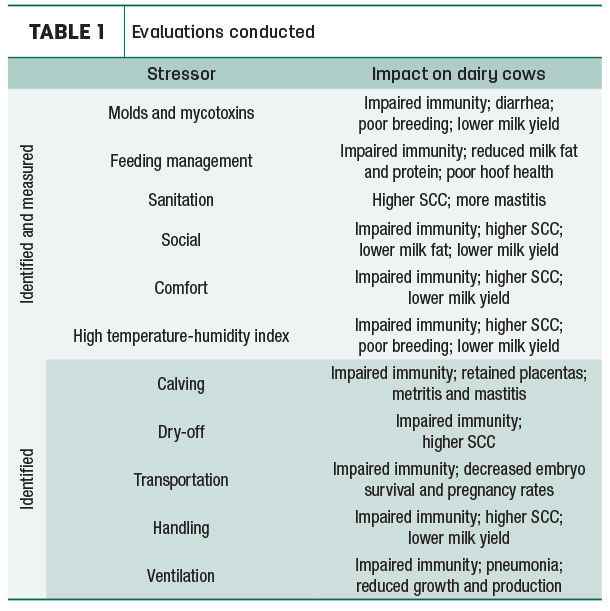If so, you’re not alone. The vast majority of Americans are stressed these days, and managing stress is a hot topic. The terms stressor and stress are commonly used when we discuss our stress; however, they are rarely ever defined.
A stressor is something real or imagined that is perceived as a threat – and stress is the body’s biological response to that threat. Stress begins in the brain and involves a cascade of hormones that ends with the release of cortisol from the adrenal glands.
Dairy cows can experience stress too. Stress can negatively affect a dairy cow’s health, milk production, reproduction and overall well-being.
Last year, our corporation launched the Phibro Stress Assessment, a systematic and comprehensive evaluation that identifies the presence and level of stressors on a dairy. A total of 11 stressors are evaluated during the stress assessment. Stressors included in the assessment have been shown, through research, to negatively impact immunity, cow health and cow performance. They are also measurable, meaning they can be accurately quantified using science-based and industry-accepted standards. Finally, the included stressors are impactful to dairy cows and dairy farms.

Earlier this year, a stress assessment was performed at Piper Farm, located in Embden, Maine. They milk approximately 600 cows, average 95 pounds of milk per cow per day with 3X milking, and have a bulk tank SCC of 65,000.
“We were interested in the assessment because of how comprehensive it is,” says Marsha Hamilton, one of the partners at Piper Farm. “Some assessments hone in on only one thing and ignore the big picture. This assessment looks at stressors on the dairy from several different angles.”
Hamilton is concerned about the stressors her cows face. Approximately six years ago, Piper Farm completed construction of a new transition cow facility that contains 30-inch headlocks and all-in-all-out management of the pre-fresh cows.
“We recognized we had social stressor issues, and we wanted to minimize them to the best of our ability,” Hamilton says.
During the stress assessment at Piper Farm, several endpoints were evaluated, measured and analyzed including stall use, consistency in TMR mixing and delivery, sorting, udder and lower leg hygiene, hock lesions, locomotion, body condition, available inches of drinking water, bunk space and herd records, just to name a few.
A farm management team meeting that included the dairy’s nutritionists, veterinarian, agronomist and several key employees was held, where the results of the stress assessment were presented. Everyone in attendance received a copy of the assessment results for the dairy in a book format.
“I really like the book,” Hamilton says. “It gives me real numbers. I have something tangible I can take to others to discuss and implement changes. It’s also very educational.”
In addition to the results of the assessment for the individual dairy, the book also contains a one-page informational sheet about each stressor.
The stress assessment can both highlight areas of success and help identify opportunities for improvement. As an example of a success, Piper Farms scored a “Low” level of stress for the Social stressor.
“We invested a lot in our transition cows with the new barn. It’s nice to get reassurance that the investment was worthwhile and helpful to the cows,” Hamilton says.
However, an opportunity for improvement was found in the Feeding Management stressor. Specifically, consistency in TMR mixing, delivery and sorting was noted as an area for improvement.
“We have considered changing our feed program to make it easier to feed cows correctly every time for a while now, and these results reinforce that we need to do something. We’ll also be looking deeper into mixing times and mixer RPMs.”
Hamilton was somewhat surprised by the score for the Comfort stressor, as more cows than expected received a locomotion score higher than desired.
“We changed the hoof trimming schedule last year,” Hamilton explains. “These results tell me cows may need to get an interim trim now. We need to check more into that.”
“With the current dairy economy, you have to find where you can improve,” Hamilton says. “Without progress, you won’t get anywhere.” ![]()
PHOTO: Marsha Hamilton, partner at Piper Farm, located in Embden, Maine. Courtesy photo.

-
Angela D. Rowson
- Dairy Technology Manager
- Phibro Animal Health Corporation
- Email Angela D. Rowson






